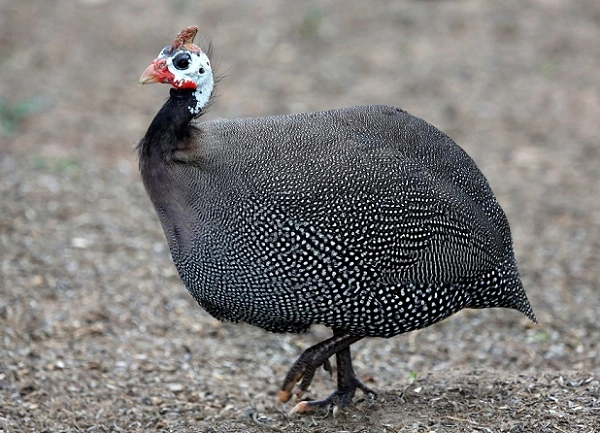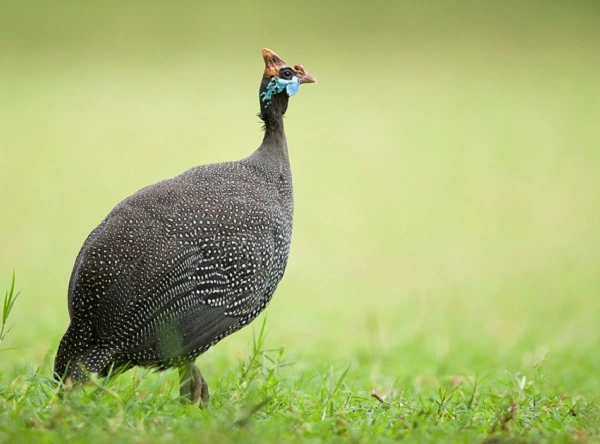Guinea fowl are an interesting and unique bird that can be a great addition to your backyard flock. These birds are not only beautiful, but they are also very hardy and have a lot of personality. If you’re thinking about adding guinea fowl to your backyard flock, here is some information on what you need to know.

Guinea Fowl Description
Guinea Fowl are native to Africa and closely related to pheasants. They are Guinea Hen-sized with a round body and short neck. Their plumage is gray or blue with white spots, and they have a bare, fleshy head with a V-shaped crest. Guinea Fowl make a loud, harsh “chanting” noise that sounds like “kek-kek-kek”. Guinea Fowl are social birds and live in flocks of 10-25 individuals. They eat insects, seeds, and greens. Guinea Fowl are considered game birds, and their meat is considered a delicacy in some parts of the world. Guinea Fowl are also used as watchdogs, as they will make loud noises to warn of intruders.
Guinea Fowl Habitat
Guinea fowl are native to Africa, and they can be found in a variety of habitats ranging from open grasslands to dense forests. Guinea fowl prefer to nest on the ground, and they will often make use of abandoned nests of other birds. In some cases, Guinea fowl will also roost in trees. Guinea fowl are opportunistic feeders, and they will eat just about anything they can find. Their diet typically includes insects, small reptiles, and seeds. Guinea fowl are social animals, and they typically live in flocks of 20 to 30 birds. Guinea fowl are hunted for their meat, which is considered to be a delicacy in many parts of Africa. The birds are also kept as pets in some areas.
Guinea Fowl Diet
Guinea Fowl are omnivores, meaning they will eat both plant and animal material. In the wild, their diet consists of a variety of insects, small mammals, reptiles, seeds, and fruits. They have also been known to eat amphibians, crustaceans, and snails. Guinea Fowl will often scratch at the ground to uncover food. Farmers sometimes keep Guinea Fowl as part of pest control efforts, as they will help to reduce the population of harmful insects. Guinea Fowl are also sometimes kept as pets. When kept as a pet, Guinea Fowl should be provided with a diet that consists of pellets, vegetables, and fruits. Guinea Fowl are interesting birds that can make a valuable addition to any farm or home.

Guinea Fowl Size
Guinea fowl are usually about the same size as a chicken, but some Guinea fowl can be quite large. The largest Guinea fowl on record was nearly three feet long and weighed more than eight pounds. Guinea fowl are usually a grey or brown color, but some Guinea fowl can be white or even black. Guinea fowl are known for their loud, repetitive calls, which can be quite annoying to some people. Guinea fowl are also known for being good at keeping pests under control. In many parts of Africa, Guinea fowl are raised for their meat, which is considered to be rather tough but flavorful. Guinea fowl can also be kept as pets, although they require a bit more care than most other domesticated animals.
Guinea Fowl Lifespan
Guinea fowl are among the oldest domesticated bird species in the world, with a history that stretches back thousands of years. Guinea fowl are native to Africa, where they have been traditionally used for their meat and eggs. In recent years, however, Guinea fowl have become popular pets in the western world. Guinea fowl are relatively low-maintenance birds, and their lifespan can be quite long if they are well cared for. The average Guinea fowl lifespan is 10-12 years, but some individual birds have been known to live for 20 years or more. With proper care, your Guinea fowl can enjoy a long and healthy life.
Guinea Fowl Behavior
Guinea fowl are interesting birds that have many unique behaviors. For example, they often form social pairs or small flocks and spend much of their time foraging for food. Guinea fowl are also known for their loud calls, which they use to communicate with each other. Another interesting behavior of Guinea fowl is their dust bathing behavior, which helps them to stay clean and eliminates parasites. Lastly, Guinea fowl also have a well-developed sense of hearing, which helps them to avoid predators. Overall, Guinea fowl are fascinating birds with many different behaviors.
Guinea Fowl Speed
Guinea fowl are fast birds. They can run at speeds of up to 30 miles per hour. Guinea fowl are also good at flying. They can reach speeds of up to 60 miles per hour when they are flying.
Guinea Fowl Hunting
Guinea fowl hunting is a popular pastime in many parts of the world. These birds are known for their tasty meat and their loud, distinctive call. Guinea fowl are also relatively easy to hunt, as they are not very shy and are often found in open areas. Although guinea fowl hunting can be a fun and rewarding experience, there are a few things that Hunters should keep in mind. First, these birds can be quite elusive, so it is important to be patient and stay alert. Second, Guinea fowl are known to fly long distances, so hunters should be prepared to travel. Finally, Guinea fowl hunting is best done in groups, as these birds can be difficult to take down alone. by working together, hunters can increase their chances of success. Guinea fowl hunting can be a great way to enjoy the outdoors and get some delicious meat at the same time. Just remember to take your time, be prepared to travel, and hunt in groups for the best results.
Conclusion
Guinea fowl are interesting birds that can be used for pest control on your property. If you’re interested in adding guinea fowl to your farm or homestead, there are a few things you should know before getting started. We’ve provided some information about these interesting birds below to help you get started. Have you ever raised guinea fowl? What tips would you add?
Frequently Asked Question

